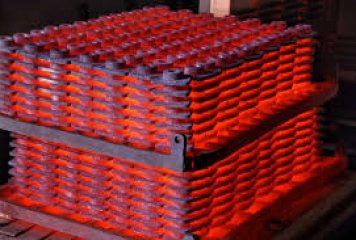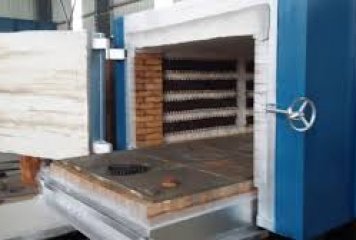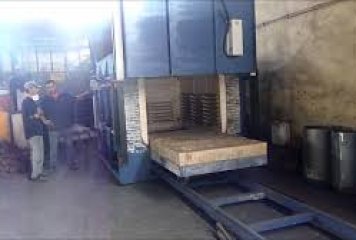Normalization Ovens
NORMALIZATION ANNEALING WORK
Normalization; It is a heat treatment that consists of heating at the temperature above the upper conversion temperature of the steel and cooling in the stagnant air in order to reduce the grain, obtain a homogeneous microstructure and improve the mechanical properties. Normalization heat treatment is carried out by heating the A3 or Acım curves at a temperature of 30-50 ° C, depending on the carbon content of the steel, ideally waiting and cooling in a calm outside the furnace. Steel, having HMK structure and Ferrite phase at room temperature, transforms into YMK lattice structure and austenite phase in internal structure by showing allotropic conversion at temperatures of 30-50 ° C above A3 or Acım curves. In heating above the specified temperature, it causes grain growth in the internal structure and carbon loss (decarburization) of the surface area. With normalization heat treatment, it is applied to semi-products or cast steel materials to facilitate more machining in the structure and to increase the performance of the material in heat treatment. It can also be made to fine-grain the coarse-grained structure in parts that have been forged at high temperature, rolled, or under the influence of environmental or regional heat, such as welding seams. Machining and or surface finishing may then be required to remove the heating layers. Air-hardening steels, such as some automotive gear steels, are often subjected to additional tempering heat treatment to soften the structure and / or increase traceability after normalization.
Normalization annealing stages
The surface of the heat treatment part is cleaned.
In the Fe-Fe3C phase diagram, the part is heated at a temperature of 30-50 ° C above the Acim curve for A3 above the eutectoid steels for sub-eutectoid steels.
Depending on the thickness or diameter of the heat treatment part, it is kept in an ideal time at the heat treatment temperature. The transformation of the structure into austenite phase is essential. So retention time is important.
The heat treatment piece is cooled in a calm air outside the oven.
Depending on the conditions of use, additional tempering or stress relieving heat treatments can be applied.
Hardness and strength values of the heat treatment part are reported. If necessary, the internal structure is analyzed by metallographic examination.
Purposes of the normalization annealing
Creating a homogeneous internal structure
Shrink grain size
Improving the mechanical properties of steels
To increase the hardness and strength of steels with softening annealing
Normalization annealing is applied in what situations
In the normalization of internal structure formations related to hot deformation after forging and other plastic forming processes,
After diffusion annealing and before quenching to obtain fine grain structure,
To save steel cast parts from the rough and brittle internal structure (Windmannstatten structure) after casting, to improve their strength and toughness properties,
In order to reduce the anisotropic effects and brittle fracture tendency that may occur due to the rolling texture after hot rolling,
Applying instead of recrystallization annealing, so as not to cause grain growth during recrystallization,
After welding applications, the base metal is applied to create a homogeneous grain structure between the region (transition zone) under the influence of heat and the weld seam.



